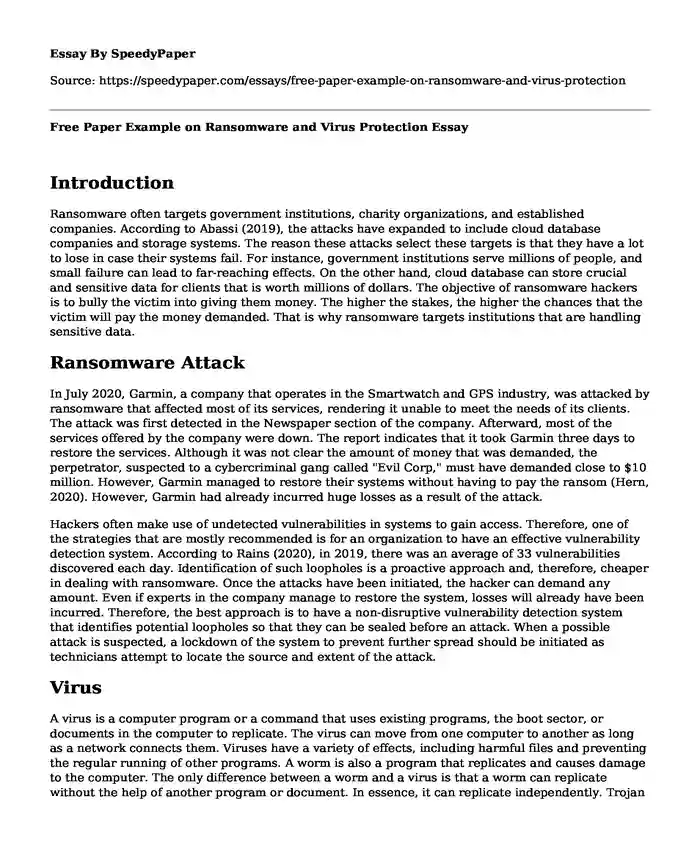
| Type of paper: | Essay |
| Categories: | Cyber security |
| Pages: | 3 |
| Wordcount: | 718 words |
Introduction
Ransomware often targets government institutions, charity organizations, and established companies. According to Abassi (2019), the attacks have expanded to include cloud database companies and storage systems. The reason these attacks select these targets is that they have a lot to lose in case their systems fail. For instance, government institutions serve millions of people, and small failure can lead to far-reaching effects. On the other hand, cloud database can store crucial and sensitive data for clients that is worth millions of dollars. The objective of ransomware hackers is to bully the victim into giving them money. The higher the stakes, the higher the chances that the victim will pay the money demanded. That is why ransomware targets institutions that are handling sensitive data.
Ransomware Attack
In July 2020, Garmin, a company that operates in the Smartwatch and GPS industry, was attacked by ransomware that affected most of its services, rendering it unable to meet the needs of its clients. The attack was first detected in the Newspaper section of the company. Afterward, most of the services offered by the company were down. The report indicates that it took Garmin three days to restore the services. Although it was not clear the amount of money that was demanded, the perpetrator, suspected to a cybercriminal gang called "Evil Corp," must have demanded close to $10 million. However, Garmin managed to restore their systems without having to pay the ransom (Hern, 2020). However, Garmin had already incurred huge losses as a result of the attack.
Hackers often make use of undetected vulnerabilities in systems to gain access. Therefore, one of the strategies that are mostly recommended is for an organization to have an effective vulnerability detection system. According to Rains (2020), in 2019, there was an average of 33 vulnerabilities discovered each day. Identification of such loopholes is a proactive approach and, therefore, cheaper in dealing with ransomware. Once the attacks have been initiated, the hacker can demand any amount. Even if experts in the company manage to restore the system, losses will already have been incurred. Therefore, the best approach is to have a non-disruptive vulnerability detection system that identifies potential loopholes so that they can be sealed before an attack. When a possible attack is suspected, a lockdown of the system to prevent further spread should be initiated as technicians attempt to locate the source and extent of the attack.
Virus
A virus is a computer program or a command that uses existing programs, the boot sector, or documents in the computer to replicate. The virus can move from one computer to another as long as a network connects them. Viruses have a variety of effects, including harmful files and preventing the regular running of other programs. A worm is also a program that replicates and causes damage to the computer. The only difference between a worm and a virus is that a worm can replicate without the help of another program or document. In essence, it can replicate independently. Trojan horses are malicious programs that hide inside simple programs to avoid detection. They usually evade the security system using this strategy because that can manage to pass as safe programs while at the same time executing their damaging effects (Gordon & Garrie, 2020).
Conclusion
The three most common commercially available antivirus software are Kaspersky, Norton, and Avira. The features of Kaspersky is that it protects the PC and android devices from attacks, secures passwords and sensitive documents, and encrypts data that is sent online. On the other hand, Norton also PC protection and VPN to ensure privacy while one is operating online. Avira antivirus software provides additional services of cleaning the PC for faster performance. Avira guarantees basic security, such as protection against identity theft. I would recommend Avira because it comes with an additional feature of cleaning up the PC.
References
Abbasi, R. (Ed.). (2019). Artificial intelligence and security challenges in emerging networks. New York, NY: IGI Global.
Gordon, L. M., & Garrie, D. B. (2020). Cybersecurity & the courthouse: Safeguarding the judicial process. New York, NY: Wolters Kluwer.
Hern, A. (2020, July 27). Ransomware attack on Garmin thought to be the work of 'Evil Corp'. The Guardian. Retrieved from
https://www.theguardian.com/technology/2020/jul/27/ransomware-attack-on-garmin-thought-to-be-the-work-of-evil-corp
Rains, T. (2020). Cybersecurity threats, malware trends, and strategies: Mitigate exploits malware, phishing, and other social engineering attacks. New York, NY: PackT.
Cite this page
Free Paper Example on Ransomware and Virus Protection. (2023, Nov 24). Retrieved from https://speedypaper.com/essays/free-paper-example-on-ransomware-and-virus-protection
Request Removal
If you are the original author of this essay and no longer wish to have it published on the SpeedyPaper website, please click below to request its removal:
- State vs. Human Security, Free Essay from Our Database
- Essay Sample on Healthcare Data Shortages
- US National Response to Weapons of Mass Destruction, Essay Example
- Essay Example on Government Privilege and Immunity
- Free Essay: Army Knowledge Online
- Essay Example - Israeli-Palestine Relations
- Essay Sample on Online Identity Theft: A Growing Threat in the Digital World
Popular categories




